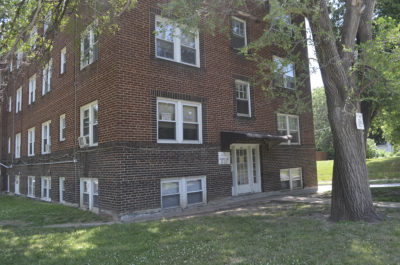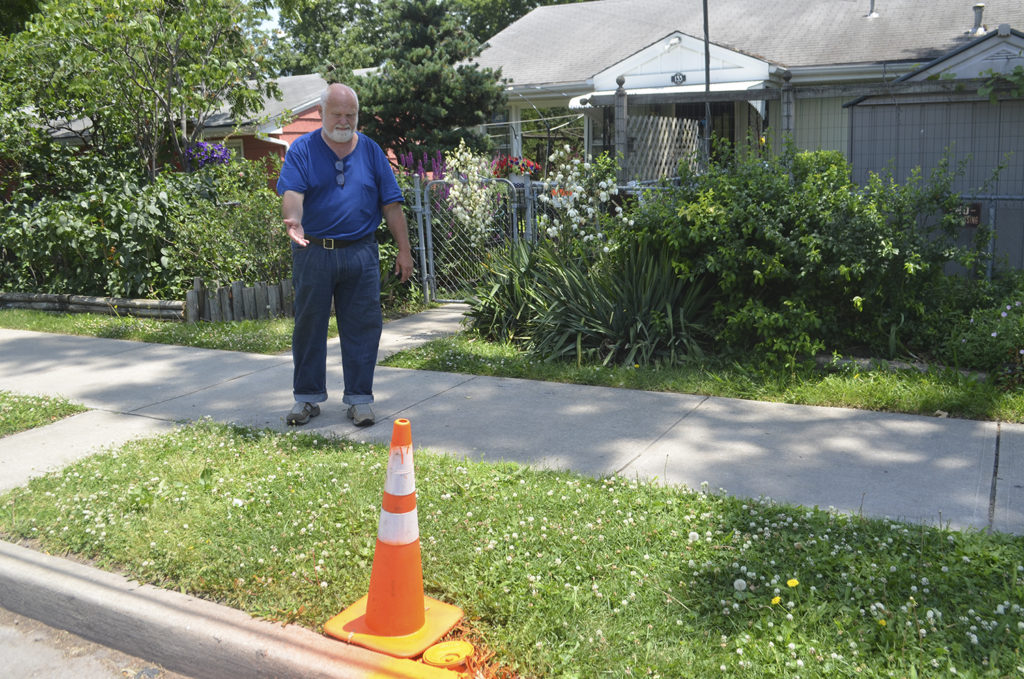Northeast News
June 22, 2017
KANSAS CITY, Missouri – The victim in an early-morning June 10 robbery near the intersection of Hardesty and Anderson is still seeking answers – and a sense of normalcy – after an ordeal that left her bruised and badly shaken.
Susan (Editor’s note: The victim’s name has been altered at her request) was heading to work – walking southbound on Hardesty towards her bus stop – just after 5:00 a.m. on the morning of Saturday, June 10 when Kansas City’s latest surge of violent crime left an indelible image on her life. As she was approaching Anderson Avenue, Susan noticed a man standing outside of Shadow Lawn Apartments, shaking out a tarp. He was standing right next to a black car, and she can’t forget his description. Black male, white tank t-shirt, gold pants, bald and wearing glasses. What happened next has been branded into her memory.
“He came up behind me and threw that tarp over my head as I was walking down to the Avenue,” Susan said. “He hit me on the back of the head with his fist, and I went down real quick.”
From there, the attacker violently tore Susan’s purse off her shoulder, jumped into the black sedan, and jetted off into the night. Susan says that he made off with her photo identification, Social Security card, debit card, food stamp card, monthly bus pass, a recently purchased phone and a portable phone charger.
“I started stumbling and trying to walk back up the street towards St. John,” Susan said. “I just fell to the ground right in front of St. John.”

Susan collapsed on the sidewalk in front of Clinton Benne’s house. The retired postman had been out in the yard with his dogs when he heard a commotion going on down the street. After seeing Susan collapse in the street, Benne rushed over, called 911 and stayed by her side until an ambulance arrived more than 20 minutes later.
“He was out there with his dog, and he knew something was off straight away,” Susan said. “Thank God he did; I’m still scared.”
Suffering from a concussion and the trauma of a violent attack, Susan says that she fell in and out of consciousness and struggled to breathe. To Susan, Benne’s help was critical. To this day, she remains terrified to walk down Hardesty; otherwise, she said, she would have already thanked Benne personally for his support.
“I’ve been meaning to go to his house, but I can’t bring myself to go down that street anymore. Not even in the day time; I can’t,” Susan said. “I would say thank you to him, and tell him how grateful I was that he was there when I needed someone.”
To Benne, though, his role in the incident was what any good-hearted person would have done in the same situation.
“What kind of person wouldn’t do that? It ain’t being a hero; it’s being a human being,” Benne said. “If that guy had been out here, I would have been on him like a pit bull.”
“This could have been my wife; she’s got to park right there.” Benne added. “Nobody should be assaulted; nobody running for a bus should get beat down.”
In describing his recollection of the scene, Benne said that when officers arrived they indicated that they’d been dispatched from South Kansas City due to a manpower shortage.
After the incident, Susan, Benne and law enforcement personnel expressed hope that a security camera located in Budd Park, which is located right across the street from where the robbery occurred, may be able to assist in the apprehension of the suspect. Sources within East Patrol, however, indicated that after reaching out to the Law Enforcement Resource Center (LERC), they had been informed that the cameras weren’t operational at the time of the incident due to a technical issue. Though the issue was resolved by June 14 and the city-owned camera is currently operational, the Budd Park camera will not provide any additional details related to the crime.
The attack serves as a prescient anecdote as law enforcement personnel both locally and nationally are coming to grips with the fact that more needs to be done to combat violent crime in Kansas City.
As for the issue of arrival time, East Patrol Community Interaction Officer Greg Smith told the Northeast News last week that the department simply has fewer officers on the streets than in years past. That problem is exacerbated late at night and early in the morning, when staffing is especially slim.
“A lot of times, p.m. shifts are running with 11 officers, 14 officers. They used to always run with more than 20 officers,” Smith said. “We just don’t have the resources out here on the streets like we used to have.”
Smith retains hope that with the release of an in-progress KCPD staffing study, more can be done to buttress a department that is struggling to combat crime in Kansas City. Until then, KCPD is doing what it can to stem the flow of violence.
“I think everybody wants to see the staffing study. I think everybody wants to hear what it actually says,” Smith said. “Crime is real. We’re way above the homicide rate where we have been. We’re going to break the record if it continues.”
Interim Chief of Police David Zimmerman has made at least one change to address the problem, realigning the schedules of Traffic Unit officers to establish a greater police presence during high-crime hours late at night.
“We have these zones now that they’re assigned to, where the high crime is. Two traffic officers are paired up to work a certain zone,” Smith said. “They’re monitoring zones and making traffic stops. They’ve made some effective arrests already.”
Zimmerman himself weighed in on the violent crime issue in a Monday, June 19 post on the KCPD Chief’s Blog. In addition to the Traffic Division, the Interim Chief wrote that the Special Operations Division and the Violent Crimes Enforcement Division – which Zimmerman notes is the enforcement arm of the Kansas City No Violence Alliance (KC NoVA) – will also be utilized to “proactively patrol” sections of the city that have been adversely impacted by violent crime. Zimmerman hopes that the extra reinforcements in high-level crime zones will help reassure neighborhoods and incite stronger partnerships with KCPD.
“We are putting extra resources in these violence-stricken neighborhoods to help the residents feel safer where they live. I want these officers to build relationships with the residents and deter violent crime, not stop and cite law-abiding citizens for minor infractions,” Zimmerman wrote. “We hope the residents will partner with us to warn us of festering disagreements that could escalate into violence, possible instances of retaliation or provide information that may help solve violent crimes.”
Also in the interest of creating better relationships with the community, The Greater Kansas City Crimestoppers – an organization which operates Kansas City’s primary anonymous tips hotline – are currently working on a pilot program focused on building trust with pre-teens. The East Patrol pilot program will focus on building and sustaining positive relationships between KCPD and Kansas City youth. To that end, police officers who have positive interactions will local youth will be able to offer special gift bags containing a rubber bracelet, a QuikTrip coupon for a free drink and a certificate that explains how to submit anonymous tips through a variety of platforms.
East Patrol Division Officer Vito Mazzara hopes that the gift bags will soon contain coupons for prominent Independence Avenue businesses, as well.
“We’re going to try and get some of the businesses in the Northeast to get involved,” Mazzara said.
Mazzara emphasized that recipients of these gift bags – preferably kids between the ages of 10 and 13 – will not be expected to do more than have a cordial conversation with a police officer.
“We don’t take any information, we don’t take anything from them, it’s just to come and talk,” Mazzara said.
On a higher level, the federal government has even gotten involved with the violent crime issue. Attorney General Jeff Sessions announced a 12-city partnership on Tuesday, June 20 that would provide additional resources to municipalities hit hardest by violent crime. Kansas City, Missouri is notably included on the list of cities set to receive the training and data analysis, along with Birmingham, Alabama; Indianapolis, Indiana; Memphis, Tennessee; Toledo, Ohio; Baton Rouge, Louisiana; Buffalo, New York; Cincinnati, Ohio; Houston, Texas; Jackson, Tennessee; Lansing, Michigan; and Springfield, Illinois.
Though the announcement didn’t include any specifics related to increased funding, it is expected to kick off a three-year instructional period during which local, state, and federal law enforcement personnel can develop greater coordination.
For Kansas City residents like Susan, the help can’t arrive soon enough.
“I want to make sure that the police find this person or persons who did this,” Susan said. “I think it should get out there. It may help someone else.”





















